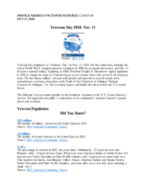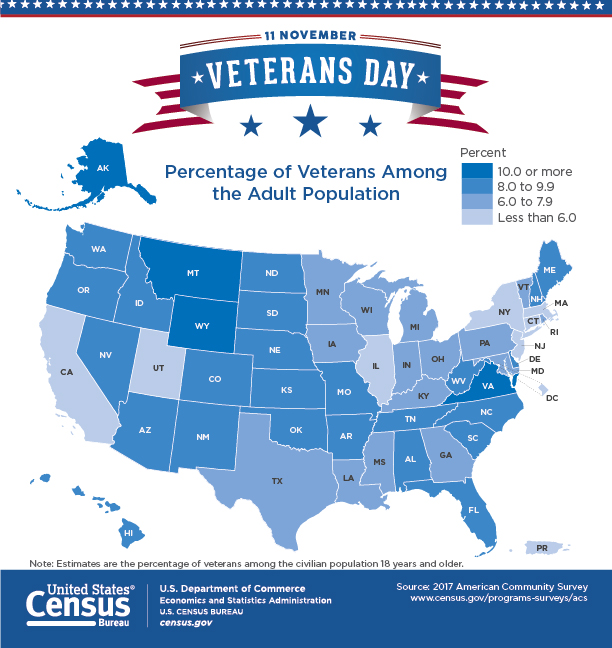Facts for Features: Veterans Day 2018: Nov. 11
Veterans Day originated as “Armistice Day” on Nov. 11, 1919, the first anniversary marking the end of World War I. Congress passed a resolution in 1926 for an annual observance, and Nov. 11 became a national holiday beginning in 1938. President Dwight D. Eisenhower signed legislation in 1954 to change the name to Veterans Day as a way to honor those who served in all American wars. The day honors military veterans with parades and speeches across the nation and a remembrance ceremony takes place at the Tomb of the Unknowns at Arlington National Cemetery in Arlington, Va. The ceremony honors and thanks all who served in the U.S. armed forces.
The following facts are made possible by the invaluable responses to the U.S. Census Bureau’s surveys. We appreciate the public’s cooperation as we continuously measure America’s people, places and economy.
Veteran Population
Source:
Source:
11.8%
The percentage of veterans in 2017 who were black. Additionally, 77.3 percent were non-Hispanic white, 1.6 percent were Asian, 0.8 percent were American Indian or Alaska Native, 0.2 percent were Native Hawaiian or Other Pacific Islander, and 1.4 percent were some other race. (The numbers for blacks, non-Hispanic whites, Asians, American Indians and Alaska Natives, Native Hawaiians and Other Pacific Islanders, and some other race cover only those reporting a single race.)
Source:
Source:
50.0%
The percentage of veterans age 65 and older in 2017. At the other end of the age spectrum, 8.9 percent were younger than age 35.
Source:
More on Veterans
See a detailed profile on the Veteran population from the 2017 American Community Survey. Statistics include:
When They Served
Demographics – Sex, Age, Race and Hispanic or Latino Origin
Median Income
Educational Attainment
Employment Status
Poverty Status
Disability Status
Related News Products
Past Facts for Features
Stats for Stories
Blogs
- Health Insurance Coverage of Veterans
- Who Are Veterans?
- Women Responsible for the Increasing Number of “Vetrepreneurs”
- Thousands of U.S. Veterans Call the Island Areas Home
- Taking a Look at Veterans Across America
Graphics
Related Info
The following is a list of observances typically covered by the Census Bureau’s Facts for Features series:
| Black (African American) History Month (February) Women's History Month (March) Irish-American Heritage Month (March) Asian/Pacific American Heritage Month (May) The Fourth of July (July 4) Anniversary of Americans With Disabilities Act (July 26) Hispanic Heritage Month (Sept. 15-Oct. 15) Halloween (Oct. 31) American Indian/Alaska Native Heritage Month (November) Veterans Day (Nov. 11) Thanksgiving Day/Holiday Season (November-December) |
Editor’s note: The preceding data were collected from a variety of sources and may be subject to sampling variability and other sources of error. Facts for Features are customarily released about two months before an observance in order to accommodate magazine production timelines. Questions or comments should be directed to the Census Bureau’s Public Information Office: telephone: 301-763-3030; or e-mail: pio@census.gov.
Profile America's Facts for Features provides statistics related to observances and holidays not covered by Stats for Stories. For observances not listed below, visit our Stats for Stories web page.
Profile America's Stats for Stories provides links to timely story ideas highlighting the Census Bureau's newsworthy statistics that relate to current events, observances, holidays, and anniversaries. The story ideas are intended to assist the media in story mining and producing content for their respective audiences.








